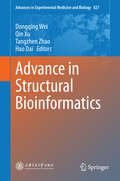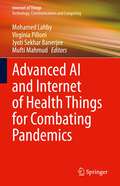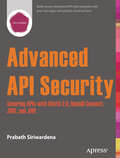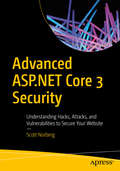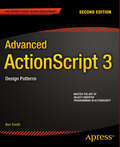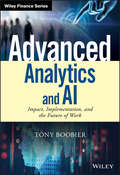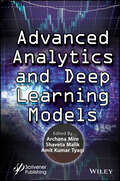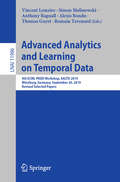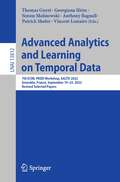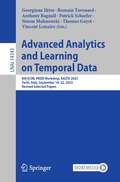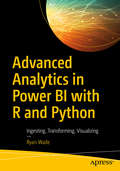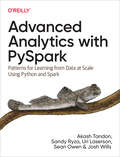- Table View
- List View
Advance in Structural Bioinformatics (Advances in Experimental Medicine and Biology #827)
by Dongqing Wei Qin Xu Tangzhen Zhao Hao DaiThis text examines in detail mathematical and physical modeling, computational methods and systems for obtaining and analyzing biological structures, using pioneering research cases as examples. As such, it emphasizes programming and problem-solving skills. It provides information on structure bioinformatics at various levels, with individual chapters covering introductory to advanced aspects, from fundamental methods and guidelines on acquiring and analyzing genomics and proteomics sequences, the structures of protein, DNA and RNA, to the basics of physical simulations and methods for conformation searches. This book will be of immense value to researchers and students in the fields of bioinformatics, computational biology and chemistry. Dr. Dongqing Wei is a Professor at the Department of Bioinformatics and Biostatistics, College of Life Science and Biotechnology, Shanghai Jiaotong University, Shanghai, China. His research interest is in the general area of structural bioinformatics.
Advanced AI Techniques and Applications in Bioinformatics (Smart and Intelligent Computing in Engineering)
by Loveleen Gaur, Arun Solanki, Samuel Fosso Wamba and Noor Zaman JhanjhiThe advanced AI techniques are essential for resolving various problematic aspects emerging in the field of bioinformatics. This book covers the recent approaches in artificial intelligence and machine learning methods and their applications in Genome and Gene editing, cancer drug discovery classification, and the protein folding algorithms among others. Deep learning, which is widely used in image processing, is also applicable in bioinformatics as one of the most popular artificial intelligence approaches. The wide range of applications discussed in this book are an indispensable resource for computer scientists, engineers, biologists, mathematicians, physicians, and medical informaticists. Features: Focusses on the cross-disciplinary relation between computer science and biology and the role of machine learning methods in resolving complex problems in bioinformatics Provides a comprehensive and balanced blend of topics and applications using various advanced algorithms Presents cutting-edge research methodologies in the area of AI methods when applied to bioinformatics and innovative solutions Discusses the AI/ML techniques, their use, and their potential for use in common and future bioinformatics applications Includes recent achievements in AI and bioinformatics contributed by a global team of researchers
Advanced AI and Data Science Applications (Advances in Computational Collective Intelligence)
by Ranjit Singh Sarban Singh D. Sivabalaselvamani G. RevathyAdvanced AI and Data Science Applications explores how the latest developments in artificial intelligence (AI) and data science are transforming diverse domains. The book blends theory and practice to serve as a roadmap to help readers understand how these cutting-edge technologies are revolutionizing practices across various fields. By providing a mix of theoretical insights and practical implementations, the book offers a holistic understanding of advanced AI and data science applications. Highlights of the book include: Metaheuristic optimization techniques for solving complex AI model training challenges The impact of AI and data science on urban development Implementing AI for enhanced cybersecurity in industrial control systems A comparative study of traditional and AI-based methods for English speech recognition Temporal dependency modeling in real-time data streams using a deep learning model Predictive analytics for financial fraud detection and risk management Data science in manufacturing for cost reduction and efficiency AI-driven agricultural analytics Featuring such advanced modeling techniques as predictive modeling, simulation, and optimization algorithms, the book presents innovative solutions that emphasize benefits and practicality. With its emphasis on interdisciplinary applications, it showcases successful projects that underscore the synergy between AI and data science domains, empowering readers to harness the power of innovation for enhanced problem-solving and efficiency in interdisciplinary realms.
Advanced AI and Internet of Health Things for Combating Pandemics (Internet of Things)
by Mufti Mahmud Mohamed Lahby Jyoti Sekhar Banerjee Virginia PilloniThis book presents the latest research, theoretical methods, and novel applications in the field of Health 5.0. The authors focus on combating COVID-19 or other pandemics through facilitating various technological services. The authors discuss new models, practical solutions, and technological advances related to detecting and analyzing COVID-19 or other pandemic based on machine intelligence models and communication technologies. The aim of the coverage is to help decision-makers, managers, professionals, and researchers design new paradigms considering the unique opportunities associated with computational intelligence and Internet of Medical Things (IoMT). This book emphasizes the need to analyze all the information through studies and research carried out in the field of computational intelligence, communication networks, and presents the best solutions to combat COVID and other pandemics.
Advanced API Security: OAuth 2.0 and Beyond
by Prabath SiriwardenaPrepare for the next wave of challenges in enterprise security. Learn to better protect, monitor, and manage your public and private APIs. Enterprise APIs have become the common way of exposing business functions to the outside world. Exposing functionality is convenient, but of course comes with a risk of exploitation. This book teaches you about TLS Token Binding, User Managed Access (UMA) 2.0, Cross Origin Resource Sharing (CORS), Incremental Authorization, Proof Key for Code Exchange (PKCE), and Token Exchange. Benefit from lessons learned from analyzing multiple attacks that have taken place by exploiting security vulnerabilities in various OAuth 2.0 implementations. Explore root causes, and improve your security practices to mitigate against similar future exploits. Security must be an integral part of any development project. This book shares best practices in designing APIs for rock-solid security. API security has evolved since the first edition of this book, and the growth of standards has been exponential. OAuth 2.0 is the most widely adopted framework that is used as the foundation for standards, and this book shows you how to apply OAuth 2.0 to your own situation in order to secure and protect your enterprise APIs from exploitation and attack. What You Will LearnSecurely design, develop, and deploy enterprise APIsPick security standards and protocols to match business needsMitigate security exploits by understanding the OAuth 2.0 threat landscapeFederate identities to expand business APIs beyond the corporate firewallProtect microservices at the edge by securing their APIsDevelop native mobile applications to access APIs securelyIntegrate applications with SaaS APIs protected with OAuth 2.0Who This Book Is ForEnterprise security architects who are interested in best practices around designing APIs. The book is also for developers who are building enterprise APIs and integrating with internal and external applications.
Advanced API Security: Securing APIs with OAuth 2.0, OpenID Connect, JWS, and JWE
by Prabath SiriwardenaAdvanced API Security is a complete reference to the next wave of challenges in enterprise security--securing public and private APIs. API adoption in both consumer and enterprises has gone beyond predictions. It has become the &‘coolest&’ way of exposing business functionalities to the outside world. Both your public and private APIs, need to be protected, monitored and managed. Security is not an afterthought, but API security has evolved a lot in last five years. The growth of standards, out there, has been exponential. That's where AdvancedAPI Security comes in--to wade through the weeds and help you keep the bad guys away while realizing the internal and external benefits of developing APIs for your services. Our expert author guides you through the maze of options and shares industry leading best practices in designing APIs for rock-solid security. The book will explain, in depth, securing APIs from quite traditional HTTP Basic Authentication to OAuth 2.0 and the standards built around it. Build APIs with rock-solid security today with Advanced API Security.Takes you through the best practices in designing APIs for rock-solid security.Provides an in depth tutorial of most widely adopted security standards for API security.Teaches you how to compare and contrast different security standards/protocols to find out what suits your business needs the best.
Advanced ASP.NET Core 3 Security: Understanding Hacks, Attacks, and Vulnerabilities to Secure Your Website
by Scott NorbergIncorporate security best practices into ASP.NET Core. This book covers security-related features available within the framework, explains where these feature may fall short, and delves into security topics rarely covered elsewhere. Get ready to dive deep into ASP.NET Core 3.1 source code, clarifying how particular features work and addressing how to fix problems. For straightforward use cases, the ASP.NET Core framework does a good job in preventing certain types of attacks from happening. But for some types of attacks, or situations that are not straightforward, there is very little guidance available on how to safely implement solutions. And worse, there is a lot of bad advice online on how to implement functionality, be it encrypting unsafely hard-coded parameters that need to be generated at runtime, or articles which advocate for certain solutions that are vulnerable to obvious injection attacks. Even more concerning is the functions in ASP.NET Core that are not as secure as they should be by default.Advanced ASP.NET Core 3 Security is designed to train developers to avoid these problems. Unlike the vast majority of security books that are targeted to network administrators, system administrators, or managers, this book is targeted specifically to ASP.NET developers. Author Scott Norberg begins by teaching developers how ASP.NET Core works behind the scenes by going directly into the framework's source code. Then he talks about how various attacks are performed using the very tools that penetration testers would use to hack into an application. He shows developers how to prevent these attacks. Finally, he covers the concepts developers need to know to do some testing on their own, without the help of a security professional. What You Will Learn Discern which attacks are easy to prevent, and which are more challenging, in the frameworkDig into ASP.NET Core 3.1 source code to understand how the security services workEstablish a baseline for understanding how to design more secure softwareProperly apply cryptography in software developmentTake a deep dive into web security conceptsValidate input in a way that allows legitimate traffic but blocks malicious traffic Understand parameterized queries and why they are so important to ASP.NET CoreFix issues in a well-implemented solution Know how the new logging system in ASP.NET Core falls short of security needsIncorporate security into your software development process Who This Book Is ForSoftware developers who have experience creating websites in ASP.NET and want to know how to make their websites secure from hackers and security professionals who work with a development team that uses ASP.NET Core. A basic understanding of web technologies such as HTML, JavaScript, and CSS is assumed, as is knowledge of how to create a website, and how to read and write C#. You do not need knowledge of security concepts, even those that are often covered in ASP.NET Core documentation.
Advanced ASP.NET Core 8 Security: Move Beyond ASP.NET Documentation and Learn Real Security
by Scott NorbergMost .NET developers do not incorporate security best practices when creating websites. The problem? Even if you use all of the best practices that the ASP.NET team recommends, you are still falling short in several key areas due to issues within the framework itself. And most developers don’t use all of the best practices that are recommended. If you are interested in truly top-notch security, available sources don’t give you the information you need. Most blogs and other books simply state how to use the configurations within ASP.NET, but do not teach you security as understood by security professionals. Online code samples aren't much help because they are usually written by developers who aren’t incorporating security practices. This book solves those issues by teaching you security first, going over software best practices as understood by security professionals, not developers. Then it teaches you how security is implemented in ASP.NET. With that foundation, it dives into specific security-related functionality and discusses how to improve upon the default functionality with working code samples. And you will learn how security professionals build software security programs so you can continue building software security best practices into your own Secure Software Development Life Cycle (SSDLC). What You’ll Learn Know how both attackers and professional defenders approach web security Establish a baseline of security for understanding how to design more secure software Discern which attacks are easy to prevent, and which are more challenging, in ASP.NET Dig into ASP.NET source code to understand how the security services work Know how the new logging system in ASP.NET falls short of security needs Incorporate security into your software development process Who This Book Is For Software developers who have experience creating websites in ASP.NET and want to know how to make their websites secure from hackers and security professionals who work with a development team that uses ASP.NET. To get the most out of this book, you should already have a basic understanding of web programming and ASP.NET, including creating new projects, creating pages, and using JavaScript. Topics That Are New to This Edition This edition has been updated with the following changes: Best practices and code samples updated to reflect security-related changes in ASP.NET 8 Improved examples, including a fully-functional website incorporating security suggestions Best practices for securely using Large Language Models (LLMs) and AI Expansions and clarifications throughout
Advanced ActionScript 3: Design Patterns
by Ben SmithAdvanced ActionScript 3 is a fresh look and new approach to utilizing valuable, structural techniques and methods that are commonly used in the field of rich interactive application development. With each method broken down into different strategized explanations, you'll find the approach most suitable for you. Whether it is an example you can utilize as-is, or one you can start with and develop further, you will have a glossary of definitions and organizational concepts at your fingertips.Object-oriented programming (OOP) and design patterns are not new to the field, but can often be overlooked in their value. They are, at times, not only overwhelming to learn, but difficult to put into practice. However, they are useful because they create a structure that can be broken down, rebuilt, and reused.This edition has been fully updated to reflect modern coding standards and practices.Provides the building blocks required for the implementation of OOPAddresses problems and concerns regarding OOPOffers solutions on how to approach and utilize OOP
Advanced Adobe Photoshop CS5 Revealed
by Chris BotelloDiscover all that Photoshop CS5 has to offer with ADVANCED ADOBE PHOTOSHOP CS5 REVEALED. This book teaches advanced design techniques using one of the most popular photo-editing programs on the market. Using step-by-step tutorials, readers work with curves, levels, blending modes, painting and drawing tools, and the latest Photoshop special effects to create professional-quality designs and images. They are challenged not only as Photoshop users but as designers, following the steps a designer would take to complete real-world projects. They also see what works in a design and what doesn't. Readers then take their craft to the next level by using the advanced end-of-chapter learning projects. The book's full-color interior and highly visual design make this the ideal book for learning advanced design techniques using the latest version of Adobe Photoshop.
Advanced Algorithms and Data Structures
by Marcello La RoccaAdvanced Algorithms and Data Structures introduces a collection of algorithms for complex programming challenges in data analysis, machine learning, and graph computing.Summary As a software engineer, you&’ll encounter countless programming challenges that initially seem confusing, difficult, or even impossible. Don&’t despair! Many of these &“new&” problems already have well-established solutions. Advanced Algorithms and Data Structures teaches you powerful approaches to a wide range of tricky coding challenges that you can adapt and apply to your own applications. Providing a balanced blend of classic, advanced, and new algorithms, this practical guide upgrades your programming toolbox with new perspectives and hands-on techniques. Purchase of the print book includes a free eBook in PDF, Kindle, and ePub formats from Manning Publications. About the technology Can you improve the speed and efficiency of your applications without investing in new hardware? Well, yes, you can: Innovations in algorithms and data structures have led to huge advances in application performance. Pick up this book to discover a collection of advanced algorithms that will make you a more effective developer. About the book Advanced Algorithms and Data Structures introduces a collection of algorithms for complex programming challenges in data analysis, machine learning, and graph computing. You&’ll discover cutting-edge approaches to a variety of tricky scenarios. You&’ll even learn to design your own data structures for projects that require a custom solution. What's inside Build on basic data structures you already know Profile your algorithms to speed up application Store and query strings efficiently Distribute clustering algorithms with MapReduce Solve logistics problems using graphs and optimization algorithms About the reader For intermediate programmers. About the author Marcello La Rocca is a research scientist and a full-stack engineer. His focus is on optimization algorithms, genetic algorithms, machine learning, and quantum computing. Table of Contents 1 Introducing data structures PART 1 IMPROVING OVER BASIC DATA STRUCTURES 2 Improving priority queues: d-way heaps 3 Treaps: Using randomization to balance binary search trees 4 Bloom filters: Reducing the memory for tracking content 5 Disjoint sets: Sub-linear time processing 6 Trie, radix trie: Efficient string search 7 Use case: LRU cache PART 2 MULTIDEMENSIONAL QUERIES 8 Nearest neighbors search 9 K-d trees: Multidimensional data indexing 10 Similarity Search Trees: Approximate nearest neighbors search for image retrieval 11 Applications of nearest neighbor search 12 Clustering 13 Parallel clustering: MapReduce and canopy clustering PART 3 PLANAR GRAPHS AND MINIMUM CROSSING NUMBER 14 An introduction to graphs: Finding paths of minimum distance 15 Graph embeddings and planarity: Drawing graphs with minimal edge intersections 16 Gradient descent: Optimization problems (not just) on graphs 17 Simulated annealing: Optimization beyond local minima 18 Genetic algorithms: Biologically inspired, fast-converging optimization
Advanced Analytics and AI: Impact, Implementation, and the Future of Work (Wiley Finance)
by Tony BoobierBe prepared for the arrival of automated decision making Once thought of as science fiction, major corporations are already beginning to use cognitive systems to assist in providing wealth advice and also in medication treatment. The use of Cognitive Analytics/Artificial Intelligence (AI) Systems is set to accelerate, with the expectation that it’ll be considered ‘mainstream’ in the next 5 – 10 years. It’ll change the way we as individuals interact with data and systems—and the way we run our businesses. Cognitive Analysis and AI prepares business users for the era of cognitive analytics / artificial intelligence. Building on established texts and commentary, it specifically prepares you in terms of expectation, impact on personal roles, and responsibilities. It focuses on the specific impact on key industries (retail, financial services, utilities and media) and also on key professions (such as accounting, operational management, supply chain and risk management). Shows you how users interact with the system in natural language Explains how cognitive analysis/AI can source ‘big data’ Provides a roadmap for implementation Gets you up to speed now before you get left behind If you’re a decision maker or budget holder within the corporate context, this invaluable book helps you gain an advantage from the deployment of cognitive analytics tools.
Advanced Analytics and Deep Learning Models (Next Generation Computing and Communication Engineering)
by Amit Kumar Tyagi Archana Mire Shaveta MalikAdvanced Analytics and Deep Learning Models The book provides readers with an in-depth understanding of concepts and technologies related to the importance of analytics and deep learning in many useful real-world applications such as e-healthcare, transportation, agriculture, stock market, etc. Advanced analytics is a mixture of machine learning, artificial intelligence, graphs, text mining, data mining, semantic analysis. It is an approach to data analysis. Beyond the traditional business intelligence, it is a semi and autonomous analysis of data by using different techniques and tools. However, deep learning and data analysis both are high centers of data science. Almost all the private and public organizations collect heavy amounts of data, i.e., domain-specific data. Many small/large companies are exploring large amounts of data for existing and future technology. Deep learning is also exploring large amounts of unsupervised data making it beneficial and effective for big data. Deep learning can be used to deal with all kinds of problems and challenges that include collecting unlabeled and uncategorized raw data, extracting complex patterns from a large amount of data, retrieving fast information, tagging data, etc. This book contains 16 chapters on artificial intelligence, machine learning, deep learning, and their uses in many useful sectors like stock market prediction, a recommendation system for better service selection, e-healthcare, telemedicine, transportation. There are also chapters on innovations and future opportunities with fog computing/cloud computing and artificial intelligence. Audience Researchers in artificial intelligence, big data, computer science, and electronic engineering, as well as industry engineers in healthcare, telemedicine, transportation, and the financial sector. The book will also be a great source for software engineers and advanced students who are beginners in the field of advanced analytics in deep learning.
Advanced Analytics and Learning on Temporal Data: 4th ECML PKDD Workshop, AALTD 2019, Würzburg, Germany, September 20, 2019, Revised Selected Papers (Lecture Notes in Computer Science #11986)
by Vincent Lemaire Simon Malinowski Anthony Bagnall Alexis Bondu Thomas Guyet Romain TavenardThis book constitutes the refereed proceedings of the 4th ECML PKDD Workshop on Advanced Analytics and Learning on Temporal Data, AALTD 2019, held in Würzburg, Germany, in September 2019. The 7 full papers presented together with 9 poster papers were carefully reviewed and selected from 31 submissions. The papers cover topics such as temporal data clustering; classification of univariate and multivariate time series; early classification of temporal data; deep learning and learning representations for temporal data; modeling temporal dependencies; advanced forecasting and prediction models; space-temporal statistical analysis; functional data analysis methods; temporal data streams; interpretable time-series analysis methods; dimensionality reduction, sparsity, algorithmic complexity and big data challenge; and bio-informatics, medical, energy consumption, on temporal data.
Advanced Analytics and Learning on Temporal Data: 5th ECML PKDD Workshop, AALTD 2020, Ghent, Belgium, September 18, 2020, Revised Selected Papers (Lecture Notes in Computer Science #12588)
by Vincent Lemaire Georgiana Ifrim Simon Malinowski Anthony Bagnall Thomas Guyet Romain TavenardThis book constitutes the refereed proceedings of the 4th ECML PKDD Workshop on Advanced Analytics and Learning on Temporal Data, AALTD 2019, held in Ghent, Belgium, in September 2020. The 15 full papers presented in this book were carefully reviewed and selected from 29 submissions. The selected papers are devoted to topics such as Temporal Data Clustering; Classification of Univariate and Multivariate Time Series; Early Classification of Temporal Data; Deep Learning and Learning Representations for Temporal Data; Modeling Temporal Dependencies; Advanced Forecasting and Prediction Models; Space-Temporal Statistical Analysis; Functional Data Analysis Methods; Temporal Data Streams; Interpretable Time-Series Analysis Methods; Dimensionality Reduction, Sparsity, Algorithmic Complexity and Big Data Challenge; and Bio-Informatics, Medical, Energy Consumption, Temporal Data.
Advanced Analytics and Learning on Temporal Data: 6th ECML PKDD Workshop, AALTD 2021, Bilbao, Spain, September 13, 2021, Revised Selected Papers (Lecture Notes in Computer Science #13114)
by Vincent Lemaire Georgiana Ifrim Simon Malinowski Anthony Bagnall Thomas Guyet Romain TavenardThis book constitutes the refereed proceedings of the 6th ECML PKDD Workshop on Advanced Analytics and Learning on Temporal Data, AALTD 2021, held during September 13-17, 2021. The workshop was planned to take place in Bilbao, Spain, but was held virtually due to the COVID-19 pandemic. The 12 full papers presented in this book were carefully reviewed and selected from 21 submissions. They focus on the following topics: Temporal Data Clustering; Classification of Univariate and Multivariate Time Series; Multivariate Time Series Co-clustering; Efficient Event Detection; Modeling Temporal Dependencies; Advanced Forecasting and Prediction Models; Cluster-based Forecasting; Explanation Methods for Time Series Classification; Multimodal Meta-Learning for Time Series Regression; and Multivariate Time Series Anomaly Detection.
Advanced Analytics and Learning on Temporal Data: 7th ECML PKDD Workshop, AALTD 2022, Grenoble, France, September 19–23, 2022, Revised Selected Papers (Lecture Notes in Computer Science #13812)
by Vincent Lemaire Georgiana Ifrim Simon Malinowski Anthony Bagnall Thomas Guyet Patrick ShaferThis book constitutes the refereed proceedings of the 7th ECML PKDD Workshop, AALTD 2022, held in Grenoble, France, during September 19–23, 2022.The 12 full papers included in this book were carefully reviewed and selected from 21 submissions. They were organized in topical sections as follows: Oral presentation and poster presentation.
Advanced Analytics and Learning on Temporal Data: 8th ECML PKDD Workshop, AALTD 2023, Turin, Italy, September 18–22, 2023, Revised Selected Papers (Lecture Notes in Computer Science #14343)
by Vincent Lemaire Georgiana Ifrim Simon Malinowski Anthony Bagnall Thomas Guyet Romain Tavenard Patrick SchaeferThis volume LNCS 14343 constitutes the refereed proceedings of the 8th ECML PKDD Workshop, AALTD 2023, in Turin, Italy, in September 2023. The 20 full papers were carefully reviewed and selected from 28 submissions. They are organized in the following topical section as follows: Machine Learning; Data Mining; Pattern Analysis; Statistics to Share their Challenges and Advances in Temporal Data Analysis.
Advanced Analytics and Learning on Temporal Data: 9th ECML PKDD Workshop, AALTD 2024, Vilnius, Lithuania, September 9–13, 2024, Revised Selected Papers (Lecture Notes in Computer Science #15433)
by Vincent Lemaire Georgiana Ifrim Simon Malinowski Anthony Bagnall Thomas Guyet Romain Tavenard Patrick SchäferThis book constitutes the refereed proceedings of the 9th ECML PKDD workshop on Advanced Analytics and Learning on Temporal Data, AALTD 2024, held in Vilnius, Lithuania, during September 9-13, 2024. The 8 full papers presented here were carefully reviewed and selected from 15 submissions. The papers focus on recent advances in Temporal Data Analysis, Metric Learning, Representation Learning, Unsupervised Feature Extraction, Clustering, and Classification.
Advanced Analytics for Industry 4.0: Traditional Industries
by Ali SoofastaeiThe evolution of modern technology has affected all the industry dimensions. Mother industries play a critical role in providing the precursor materials for other industries, and a small improvement in these can make a big change in others. This book covers the analytics revolution in Industry 4.0 for the mother industries, such as mining, oil and gas, and steel. It focuses on the use of advanced analytics and artificial intelligence to improve the business decisions aimed at increasing the quality and quantity of mother industries' products. It helps to design and implement their digital transformation strategies in these industries.Key Features: Provides a concise overview of state of the art for mother industries' executives and managers. Highlights and describes critical opportunity areas for industry operations optimization. Explains how to implement advanced data analytics through case studies and examples. Provides approaches and methods to improve data-driven decision-making. Brings experience and learning in digital transformation from adjacent sectors. This book is aimed at researchers, professionals, and graduate students in data science, manufacturing, automation, and computer engineering.
Advanced Analytics in Mining Engineering: Leverage Advanced Analytics in Mining Industry to Make Better Business Decisions
by Ali SoofastaeiIn this book, Dr. Soofastaei and his colleagues reveal how all mining managers can effectively deploy advanced analytics in their day-to-day operations- one business decision at a time.Most mining companies have a massive amount of data at their disposal. However, they cannot use the stored data in any meaningful way. The powerful new business tool-advanced analytics enables many mining companies to aggressively leverage their data in key business decisions and processes with impressive results.From statistical analysis to machine learning and artificial intelligence, the authors show how many analytical tools can improve decisions about everything in the mine value chain, from exploration to marketing.Combining the science of advanced analytics with the mining industrial business solutions, introduce the “Advanced Analytics in Mining Engineering Book” as a practical road map and tools for unleashing the potential buried in your company’s data.The book is aimed at providing mining executives, managers, and research and development teams with an understanding of the business value and applicability of different analytic approaches and helping data analytics leads by giving them a business framework in which to assess the value, cost, and risk of potential analytical solutions. In addition, the book will provide the next generation of miners – undergraduate and graduate IT and mining engineering students – with an understanding of data analytics applied to the mining industry. By providing a book with chapters structured in line with the mining value chain, we will provide a clear, enterprise-level view of where and how advanced data analytics can best be applied. This book highlights the potential to interconnect activities in the mining enterprise better. Furthermore, the book explores the opportunities for optimization and increased productivity offered by better interoperability along the mining value chain – in line with the emerging vision of creating a digital mine with much-enhanced capabilities for modeling, simulation, and the use of digital twins – in line with leading “digital” industries.
Advanced Analytics in Power BI with R and Python: Ingesting, Transforming, Visualizing
by Ryan WadeThis easy-to-follow guide provides R and Python recipes to help you learn and apply the top languages in the field of data analytics to your work in Microsoft Power BI. Data analytics expert and author Ryan Wade shows you how to use R and Python to perform tasks that are extremely hard, if not impossible, to do using native Power BI tools. For example, you will learn to score Power BI data using custom data science models and powerful models from Microsoft Cognitive Services. The R and Python languages are powerful complements to Power BI. They enable advanced data transformation techniques that are difficult to perform in Power BI in its default configuration but become easier by leveraging the capabilities of R and Python. If you are a business analyst, data analyst, or a data scientist who wants to push Power BI and transform it from being just a business intelligence tool into an advanced data analytics tool, then this is the book to help you do that. What You Will Learn Create advanced data visualizations via R using the ggplot2 package Ingest data using R and Python to overcome some limitations of Power Query Apply machine learning models to your data using R and Python without the need of Power BI premium compacity Incorporate advanced AI in Power BI without the need of Power BI premium compacity via Microsoft Cognitive Services, IBM Watson Natural Language Understanding, and pre-trained models in SQL Server Machine Learning Services Perform advanced string manipulations not otherwise possible in Power BI using R and Python Who This Book Is For Power users, data analysts, and data scientists who want to go beyond Power BI’s built-in functionality to create advanced visualizations, transform data in ways not otherwise supported, and automate data ingestion from sources such as SQL Server and Excel in a more concise way
Advanced Analytics with PySpark: Patterns for Learning from Data at Scale Using Python and Spark
by Uri Laserson Josh Wills Sandy Ryza Sean Owen Akash TandonThe amount of data being generated today is staggering and growing. Apache Spark has emerged as the de facto tool to analyze big data and is now a critical part of the data science toolbox. Updated for Spark 3.0, this practical guide brings together Spark, statistical methods, and real-world datasets to teach you how to approach analytics problems using PySpark, Spark's Python API, and other best practices in Spark programming.Data scientists Akash Tandon, Sandy Ryza, Uri Laserson, Sean Owen, and Josh Wills offer an introduction to the Spark ecosystem, then dive into patterns that apply common techniques-including classification, clustering, collaborative filtering, and anomaly detection, to fields such as genomics, security, and finance. This updated edition also covers NLP and image processing.If you have a basic understanding of machine learning and statistics and you program in Python, this book will get you started with large-scale data analysis.Familiarize yourself with Spark's programming model and ecosystemLearn general approaches in data scienceExamine complete implementations that analyze large public datasetsDiscover which machine learning tools make sense for particular problemsExplore code that can be adapted to many uses
Advanced Analytics with Spark
by Uri Laserson Josh Wills Sandy Ryza Sean OwenIn this practical book, four Cloudera data scientists present a set of self-contained patterns for performing large-scale data analysis with Spark. The authors bring Spark, statistical methods, and real-world data sets together to teach you how to approach analytics problems by example.You'll start with an introduction to Spark and its ecosystem, and then dive into patterns that apply common techniques--classification, collaborative filtering, and anomaly detection among others--to fields such as genomics, security, and finance. If you have an entry-level understanding of machine learning and statistics, and you program in Java, Python, or Scala, you'll find these patterns useful for working on your own data applications.Patterns include:Recommending music and the Audioscrobbler data setPredicting forest cover with decision treesAnomaly detection in network traffic with K-means clusteringUnderstanding Wikipedia with Latent Semantic AnalysisAnalyzing co-occurrence networks with GraphXGeospatial and temporal data analysis on the New York City Taxi Trips dataEstimating financial risk through Monte Carlo simulationAnalyzing genomics data and the BDG projectAnalyzing neuroimaging data with PySpark and Thunder
Advanced Analytics with Spark: Patterns for Learning from Data at Scale
by Uri Laserson Josh Wills Sandy Ryza Sean OwenIn the second edition of this practical book, four Cloudera data scientists present a set of self-contained patterns for performing large-scale data analysis with Spark. The authors bring Spark, statistical methods, and real-world data sets together to teach you how to approach analytics problems by example. Updated for Spark 2.1, this edition acts as an introduction to these techniques and other best practices in Spark programming.You’ll start with an introduction to Spark and its ecosystem, and then dive into patterns that apply common techniques—including classification, clustering, collaborative filtering, and anomaly detection—to fields such as genomics, security, and finance.If you have an entry-level understanding of machine learning and statistics, and you program in Java, Python, or Scala, you’ll find the book’s patterns useful for working on your own data applications.With this book, you will:Familiarize yourself with the Spark programming modelBecome comfortable within the Spark ecosystemLearn general approaches in data scienceExamine complete implementations that analyze large public data setsDiscover which machine learning tools make sense for particular problemsAcquire code that can be adapted to many uses
